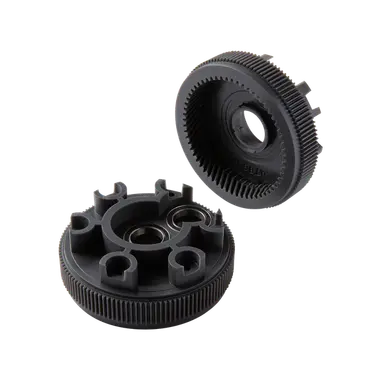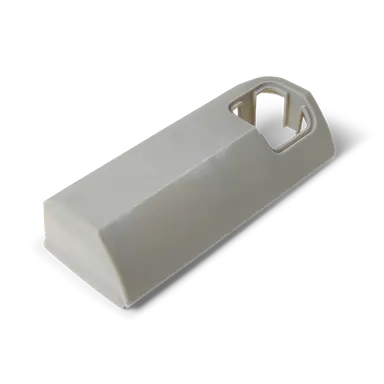Ultimate Tensile Strength (MPa)
Tensile Modulus (GPa)
Flexural Modulus (GPa)
Heat Deflection Temp @0.45 MPa (°C)
Elongation at Break (%)
Notched IZOD (J/m)
Prefer spreadsheets? See all material datasheets in one place with a live updating spreadsheet here.
Sort by:
Featured
Price (lowest)
A-Z
Ultimate Tensile Strength (highest)
Elongation at Break (highest)
Flexural Strength (highest)
Heat Deflection Temp. @ 1.8 MPa (highest)
Heat Deflection Temp. @ 0.45 MPa (highest)
Tensile Modulus (highest)
Flexural Modulus (highest)
Shore Hardness (highest)

Tough 2000 Resin V2
SLAStiff & StrongImpact ResistantABS-LikeWear Resistant
SLAStiff & StrongImpact ResistantABS-LikeWear Resistant
Tough 2000 Resin V2 is a rugged material with strength and stiffness comparable to acrylonitrile butadiene styrene (ABS), combining toughness with high temperature and creep resistance.
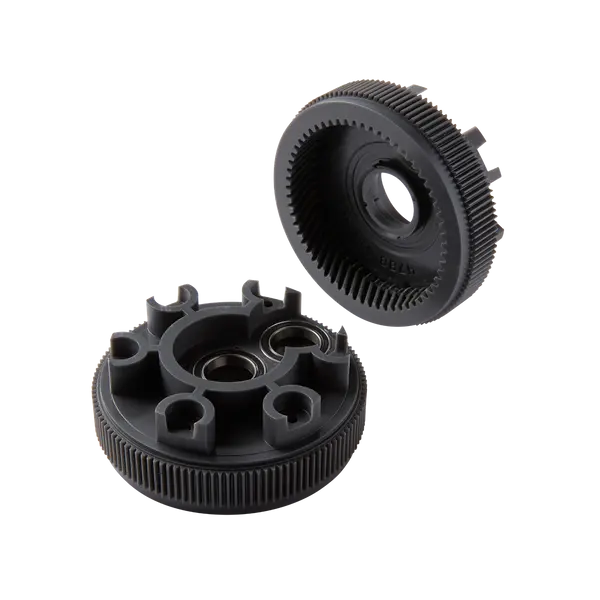
Tough 1500 Resin V2
SLAPliablePP-LikeWear Resistant
SLAPliablePP-LikeWear Resistant
Tough 1500 Resin V2 is a resilient material with strength, stiffness, and toughness comparable to polypropylene (PP), offering exceptional resistance to fractures, impacts, and shattering.
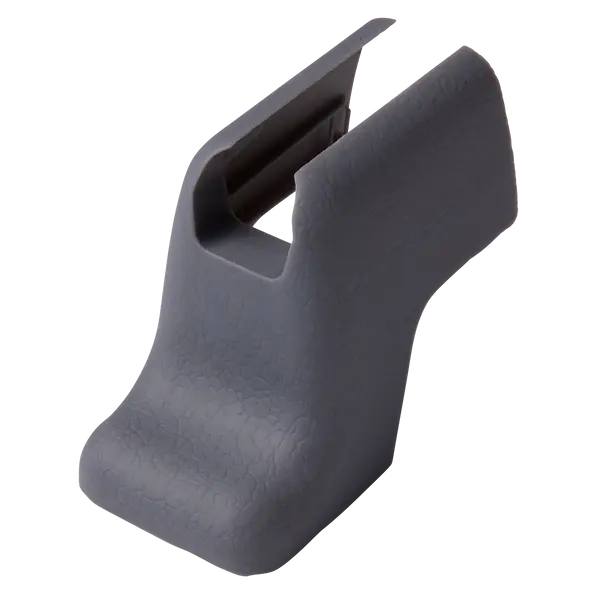
Grey Resin V4.1
SLAStiff & StrongMatteFast PrintingHigh AccuracyFine Details
SLAStiff & StrongMatteFast PrintingHigh AccuracyFine Details
Grey Resin is ideal for general-purpose prototyping and detailed models, offering a matte finish, opaque appearance, and precise details. Grey Resin V4 is compatible with Form 3 and Form 2 Series printers, while Grey Resin V5 for the Form 4 Series offers faster speed and improved mechanical properties.

White Resin V4.1
SLAStiff & StrongFine DetailsHigh StrengthHigh Accuracy
SLAStiff & StrongFine DetailsHigh StrengthHigh Accuracy
White Resin is perfect for general-purpose prototyping and design, and models with intricate details. White Resin V4.1 is compatible with Form 3 Series printers and produces brighter white parts compared to White Resin V4. Choose White Resin V5 on the Form 4 Series for three times faster print speed and improved mechanical properties.

Nylon 12 Tough Powder 10 kg
SLSRobustHigh StrengthWear ResistantUV ResistantBiocompatibility
SLSRobustHigh StrengthWear ResistantUV ResistantBiocompatibility
Nylon 12 Tough Powder offers the best-in-class refresh rate among Nylon powders, high ductility, and great dimensional accuracy across the build chamber. Print more durable parts for prototyping and small batch production that have reduced warpage without sacrificing strength.

Denture Base Resin
SLAMultiple ShadesDenture BasesWear ResistantBiocompatibility
SLAMultiple ShadesDenture BasesWear ResistantBiocompatibility
Denture Base Resin is a biocompatible material for producing long-lasting, wear-resistant denture bases and try-in dentures at a fraction of the cost of traditional methods. With four semi-translucent shades available, technicians can achieve lifelike gingiva with natural margins, whether with 3D printed denture teeth or acrylic cards.
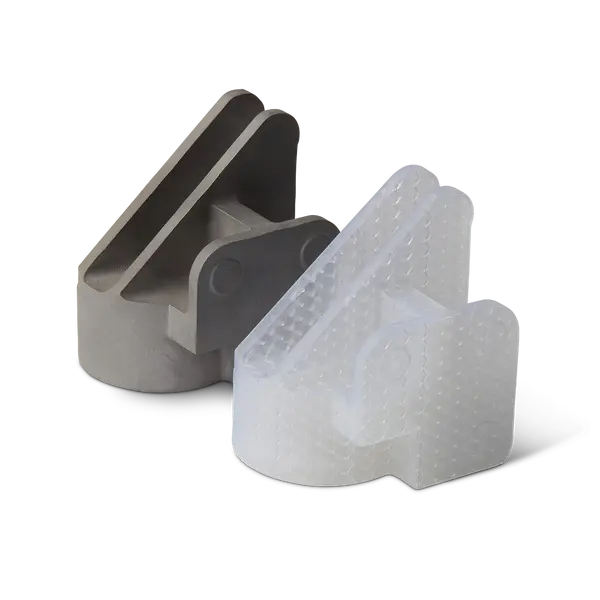
Clear Cast Resin
SLAFine DetailsInvestment CastingTransparentHigh Accuracy
SLAFine DetailsInvestment CastingTransparentHigh Accuracy
Clear Cast Resin is a resin designed for investment casting, to directly print patterns that can be invested and cast. It has an extremely low thermal expansion, low ash, and no trace heavy metals.

Nylon 12 Powder 10 kg
SLSRobustHigh StrengthWear ResistantUV ResistantBiocompatibility
SLSRobustHigh StrengthWear ResistantUV ResistantBiocompatibility
Nylon 12 Powder is a general purpose, versatile, and biocompatible material with high detail and great dimensional accuracy. As the go-to material for SLS 3D printing, it is ideal for both functional prototyping and end-use production of complex assemblies and durable parts with high environmental stability.
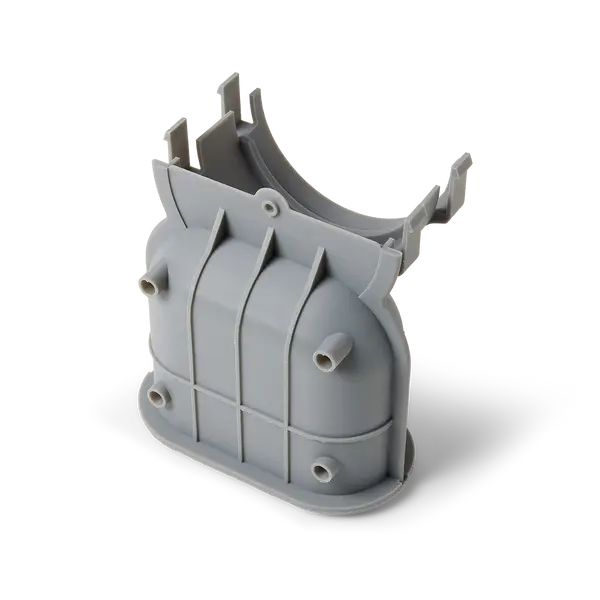
Grey Resin V5
SLAStiff & StrongMatteFast PrintingHigh AccuracyFine DetailsPost-Curing Optional
SLAStiff & StrongMatteFast PrintingHigh AccuracyFine DetailsPost-Curing Optional
Grey Resin is a versatile General Purpose Resin, offering an optimal balance of speed, accuracy, aesthetics, and mechanical properties to create parts that rival injection molding. Formulated specifically for the Form 4 Series, Grey Resin V5 prints three times faster than the previous version.
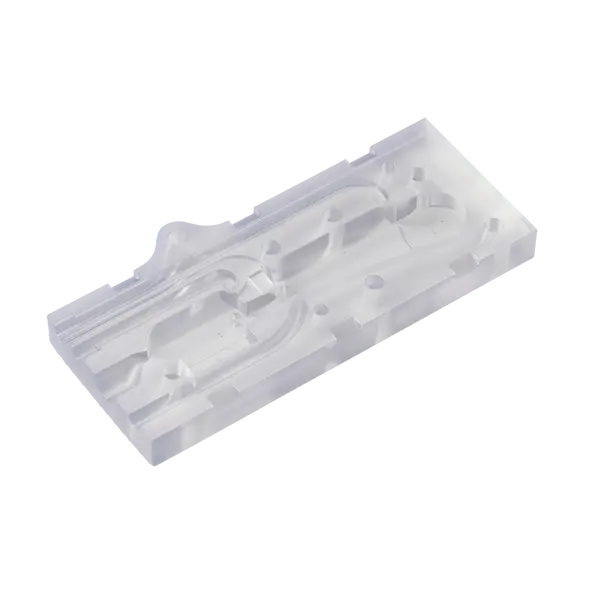
Clear Resin V5
SLAStiff & StrongHigh StrengthTransparentHigh AccuracyFine DetailsPost-Curing Optional
SLAStiff & StrongHigh StrengthTransparentHigh AccuracyFine DetailsPost-Curing Optional
Clear Resin is an exceptionally clear 3D printing resin formulated to leverage the new Form 4 ecosystem, offering an optimal balance of fast print speed, high accuracy, transparency, and strong mechanical properties to create parts that can be coated or polished to rival acrylic.

Precision Model Resin
SLAMatteHigh AccuracyFine Details
SLAMatteHigh AccuracyFine Details
Precision Model Resin is a high-accuracy material for creating restorative models with high opacity, beige color, and a smooth, matte finish to capture fine details and create crisp margin lines. Formulated specifically for the Form 4 ecosystem, this material prints three times faster than the previous version.

Flame Retardant Resin
SLAStiff & StrongHeat ResistantRobustLow CreepUL94 V0 Certified
SLAStiff & StrongHeat ResistantRobustLow CreepUL94 V0 Certified
Flame Retardant Resin is a UL 94 V-0 certified, halogen-free material with favorable flame, smoke, and toxicity (FST) ratings for creating self-extinguishing parts. Parts printed in FR Resin are stiff and creep-resistant, and will perform well long-term in indoor and industrial environments with high temperatures or ignition sources.

Color Base Resin
SLAFine DetailsCustom ColorsMatte
SLAFine DetailsCustom ColorsMatte
Color Kit is the first integrated color mixing solution for resin 3D printing. It enables 3D printing in a range of colors without the manual work of finishing, dying, or painting. Color Base Resin is the foundation to mix with any Color Kit pigment and create Color Resin.
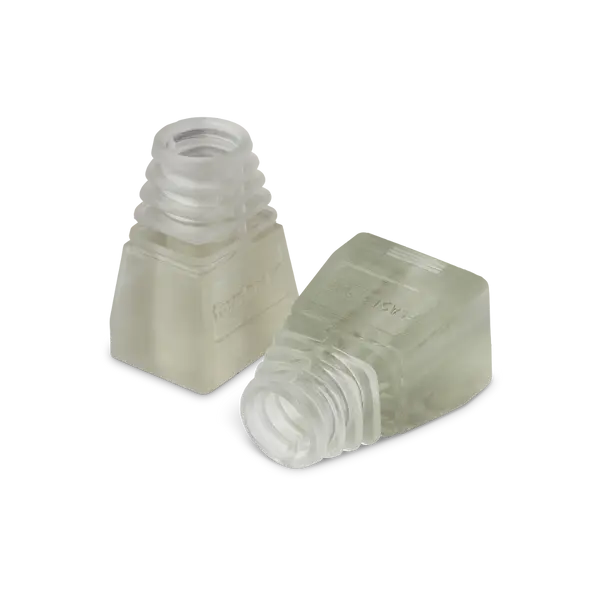
Elastic 50A Resin V2
SLATranslucentElastomericSoft Silicone-like
SLATranslucentElastomericSoft Silicone-like
Elastic 50A Resin V2 is a soft, translucent elastomer with a 50A Shore durometer that is ideal for prototyping parts normally produced with softer rubbers and silicones. Parts printed in Elastic 50A Resin will bend, stretch, compress, and hold up to repeated cycles without tearing, and spring back quickly to their original shape.

BioMed Elastic 50A Resin
SLAElastomericSoft Silicone-likeBiocompatibilityTranslucent
SLAElastomericSoft Silicone-likeBiocompatibilityTranslucent
BioMed Elastic 50A Resin is a soft, elastic, and transparent material for biocompatible applications requiring comfort and long-term skin (>30 days) or short-term mucosal membrane contact (<24 hours). BioMed Elastic 50A Resin is manufactured in our ISO 13485 certified facility.

Dental LT Comfort Resin
SLAFlexibleWear ResistantBiocompatibilityFlexible Splints and Occlusal GuardsTransparent
SLAFlexibleWear ResistantBiocompatibilityFlexible Splints and Occlusal GuardsTransparent
Dental LT Comfort Resin is a long-term biocompatible material for directly 3D printing flexible occlusal splints and night guards in-house, more easily than ever. Printed appliances are easily polished to high optical transparency, and offer enhanced comfort and durability that boosts patient adoption and compliance.
Silicone 40A Resin
SLAElastomericSoft100% SiliconeWear ResistantTear Resistant
SLAElastomericSoft100% SiliconeWear ResistantTear Resistant
Silicone 40A Resin is the first accessible 100% silicone 3D printing material, using Formlabs’ patent-pending Pure Silicone Technology™. Eliminate molding and labor-intensive casting processes by directly printing soft, pliable, and durable silicone parts in house in a matter of hours.

BioMed White Resin
SLASterilizableMatteBiocompatibility
SLASterilizableMatteBiocompatibility
BioMed White Resin is a rigid material for biocompatible applications requiring long-term skin (>30 days) or short-term bone, tissue, dentin, and mucosal membrane contact (<24 hours). BioMed White Resin is manufactured in our ISO 13485 facility.

BioMed Amber Resin
SLAStiff & StrongTranslucentSterilizableBiocompatibilityUltra High Strength
SLAStiff & StrongTranslucentSterilizableBiocompatibilityUltra High Strength
BioMed Amber Resin is a strong, stiff material for biocompatible applications requiring long-term skin (>30 days) or short-term bone, tissue, dentin, and mucosal membrane contact (<24 hours). Parts printed with BioMed Amber Resin are compatible with common solvent disinfection and sterilization methods.

ESD Resin
SLAStiff & StrongABS-LikeESD-SafeRobust
SLAStiff & StrongABS-LikeESD-SafeRobust
ESD Resin is a specialty material for producing custom ESD-safe prototypes and production tooling to increase operational efficiency and improve the yield of electronics manufacturing lines. Parts printed in ESD Resin are static-dissipative, repel dust and powder, and have high modulus and impact strength similar to ABS.

Castable Wax Resin
SLAFine DetailsWax FilledInvestment Casting
SLAFine DetailsWax FilledInvestment Casting
Castable Wax Resin is a 20% wax-filled material for casting that can capture intricate features and offers a smooth surface finish for accurate castings with zero ash content and clean burnout. It is ideal for ultrafine structures in jewelry, as well as highly accurate patterns for casting and pressing dental prosthetics.
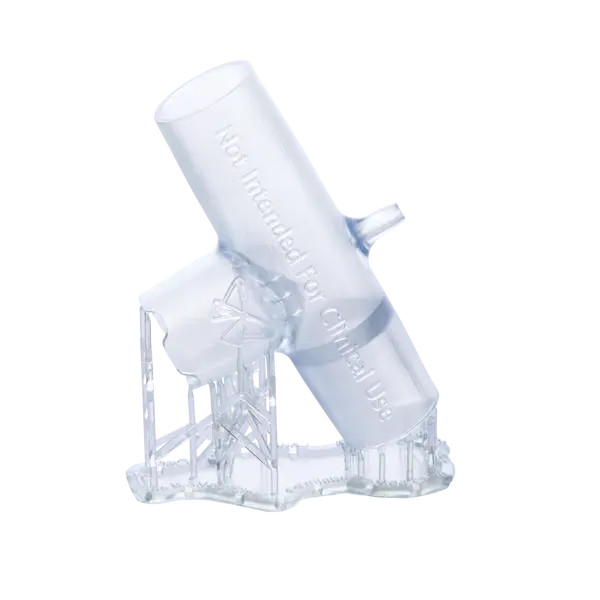
BioMed Clear Resin
SLASterilizableRobustHigh StrengthBiocompatibilityTransparent
SLASterilizableRobustHigh StrengthBiocompatibilityTransparent
BioMed Clear Resin is a hard, strong, and wear-resistant material for biocompatible applications requiring long-term skin (>30 days), breathing gas pathways, and mucosal membrane contact (>30 hours) or short-term bone, tissue, and dentin (<24 hours). Parts printed with BioMed Clear Resin are compatible with common sterilization methods.

Flexible 80A Resin
SLATranslucentHard Rubber-LikeElastomericWear Resistant
SLATranslucentHard Rubber-LikeElastomericWear Resistant
Flexible 80A Resin a stiff, soft-touch, translucent elastomer with an 80A Shore durometer that is ideal for prototyping rubber-like parts with the flexibility of harder rubber or TPU. Parts printed in Flexible 80A Resin can withstand bending, flexing, and compression, even through repeated cycles.

Rigid 4000 Resin
SLAHigh StrengthGlass FilledUltra StiffPEEK-LikeFine Details
SLAHigh StrengthGlass FilledUltra StiffPEEK-LikeFine Details
Rigid 4000 Resin is a glass-filled resin that is stiff, precise, and offers high thermal and chemical resistance. It prints with a smooth, polished finish and is ideal for industrial parts that need to withstand significant load without bending. Parts printed in Rigid 4000 have similar stiffness to PEEK and PEKK thermoplastics.

Grey Pro Resin
SLAFine DetailsMatteLow CreepHigh Strength
SLAFine DetailsMatteLow CreepHigh Strength
Grey Pro Resin is a tough and heat-resistant material with a low creep, offering improved performance compared to Formlabs General Purpose Resins. Grey Pro Resin is compatible with Form 2 and Form 3 Series printers, while Grey Resin V5 for the Form 4 Series offers improved mechanical properties and faster speed, replacing Grey Pro Resin.

Black Resin V4
SLAStiff & StrongMatteHigh StrengthHigh AccuracyFine Details
SLAStiff & StrongMatteHigh StrengthHigh AccuracyFine Details
Black Resin is perfect for general-purpose prototyping and design, and models with intricate details. Black Resin V4 is compatible with Form 3 and Form 2 Series printers. Choose Black Resin V4.1 on the Form 3 Series for deeper black parts and improved print reliability or Black Resin V5 on the Form 4 Series for three times faster print speed and improved mechanical properties.

Tough 2000 Resin
SLAStiff & StrongABS-LikeHigh StrengthWear ResistantImpact Resistant
SLAStiff & StrongABS-LikeHigh StrengthWear ResistantImpact Resistant
Tough 2000 Resin has similar strength and stiffness to ABS plastics, making it ideal for functional parts that are difficult to bend and will hold up with extended use. Choose Tough 2000 Resin for prototyping strong and sturdy parts that should not bend easily, as well as jigs and fixtures requiring minimal deflection.

Clear Resin V4
SLAStiff & StrongHigh StrengthTransparentHigh AccuracyFine Details
SLAStiff & StrongHigh StrengthTransparentHigh AccuracyFine Details
Clear Resin is a rigid material that polishes to near optical transparency. Clear Resin V4 is compatible with Form 3 and Form 2 Series printers. Choose Clear Resin V4.1 on the Form 3 Series for more color-neutral and transparent parts or Clear Resin V5 on the Form 4 Series for three times faster print speed and improved mechanical properties.

Grey Resin V4
SLAStiff & StrongMatteFast PrintingHigh AccuracyFine Details
SLAStiff & StrongMatteFast PrintingHigh AccuracyFine Details
Grey Resin is ideal for general-purpose prototyping and detailed models, offering a matte finish, opaque appearance, and precise details. Grey Resin V4 is compatible with Form 3 and Form 2 Series printers, while Grey Resin V5 for the Form 4 Series offers faster speed and improved mechanical properties.

Nylon 11 CF Powder 6 kg
SLSHeat ResistantCarbon Fiber FilledUltra StiffImpact ResistantUltra High Strength
SLSHeat ResistantCarbon Fiber FilledUltra StiffImpact ResistantUltra High Strength
Nylon 11 CF Powder is a carbon fiber-filled material, perfect for applications that require both superior stiffness and strength. Produce lightweight, rigid parts that remain structurally and thermally stable and can sustain repeated impact. Nylon 11 CF Powder requires to be printed on Fuse 1+ 30W with inert atmospheric control.

Nylon 11 Powder 6 kg
SLSHigh StrengthWear ResistantImpact ResistantUV ResistantSkin Contact
SLSHigh StrengthWear ResistantImpact ResistantUV ResistantSkin Contact
Nylon 11 Powder is a strong and highly ductile bio-based material. It is ideal for robust biocompatible parts, functional prototyping, and producing custom or low volume end-use parts that need to bend or take impact. For best results, print Nylon 11 Powder using the Fuse 1+ 30W and optional inert atmospheric control.

Color Kit (Form 3)
SLAFine DetailsMatteCustom Colors
SLAFine DetailsMatteCustom Colors
Color Kit is the first integrated color mixing solution for resin 3D printing. It enables 3D printing in a range of colors without the manual work of finishing, dying, or painting. Color Kit contains a Color Base cartridge and all five Color Pigments to mix and print matte, opaque parts in a range of colors.

Cyan Pigment
SLACustom Colors
SLACustom Colors
Cyan Pigment adds blue hues to Color Resin when mixed with Color Base Resin. Color Kit is the first integrated color mixing solution for resin 3D printing. It enables 3D printing in a range of colors without the manual work of finishing, dying, or painting.

White Pigment
SLACustom Colors
SLACustom Colors
White Pigment creates lighter shades of Color Resin when mixed with Color Base Resin. Color Kit is the first integrated color mixing solution for resin 3D printing. It enables 3D printing in a range of colors without the manual work of finishing, dying, or painting.
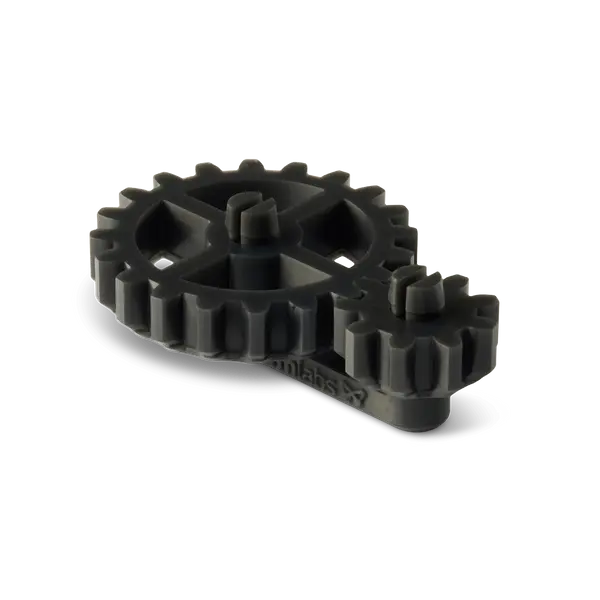
Tough 1000 Resin
SLAImpact ResistantWear ResistantHDPE-like
SLAImpact ResistantWear ResistantHDPE-like
Tough 1000 Resin is a ductile, impact-resistant material with comparable strength, stiffness, and toughness to high-density
polyethylene (HDPE), designed with exceptional wear and fatigue resistance for long-term toughness and utility.

True Cast Resin
SLAPatterns for Casting & PressingHigh AccuracyFine DetailsClean BurnoutCasting
SLAPatterns for Casting & PressingHigh AccuracyFine DetailsClean BurnoutCasting
True Cast Resin is a wax-filled 3D printing material, designed for precision casting of intricate jewelry and complex engineering components up to 5 mm.

Black Resin V4.1
SLAStiff & StrongMatteHigh StrengthHigh AccuracyFine Details
SLAStiff & StrongMatteHigh StrengthHigh AccuracyFine Details
Black Resin is perfect for general-purpose prototyping and design, and models with intricate details. Black Resin V4.1 is compatible with Form 3 Series printers, produces deeper black parts, and offers improved print reliability compared to Black Resin V4.0. Choose Black Resin V5 on the Form 4 Series for three times faster print speed and improved mechanical properties.

Clear Resin V4.1
SLAStiff & StrongHigh StrengthTransparentHigh AccuracyFine Details
SLAStiff & StrongHigh StrengthTransparentHigh AccuracyFine Details
Clear Resin is a rigid material that polishes to near optical transparency. Clear Resin V4.1 is compatible with Form 3 Series printers and creates more color-neutral and transparent parts compared to Clear Resin V4.0. Choose Clear Resin V5 on the Form 4 Series for three times faster print speed and improved mechanical properties.
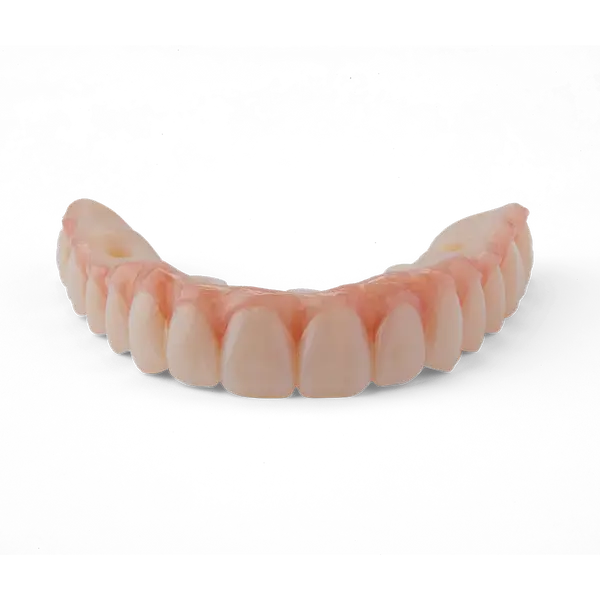
Premium Teeth Resin
SLAMultiple ShadesWear ResistantDenture TeethBiocompatibilityTemporary Full-Arch Implant-Supported Restorations (All-on-X)
SLAMultiple ShadesWear ResistantDenture TeethBiocompatibilityTemporary Full-Arch Implant-Supported Restorations (All-on-X)
Premium Teeth Resin is a nano-ceramic-filled biocompatible material with enhanced aesthetics, mechanical properties, and validated longevity to guarantee optimal clinical performance. 3D print denture teeth, temporary full-arch implant-supported restorations (All-on-X appliances), temporary single units (crowns, inlays, onlays, and veneers), and up to seven-unit bridges.
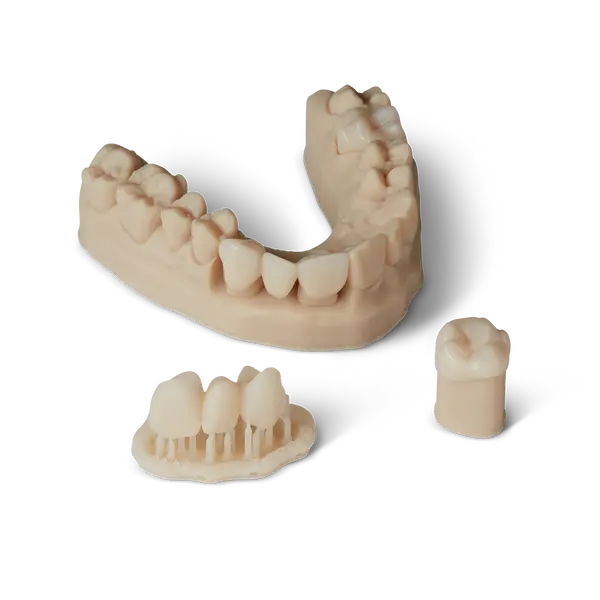
BEGO™ VarseoSmile® TriniQ® Resin
SLAMultiple ShadesCeramic FilledWear ResistantBiocompatibilityPermanent Restorations
SLAMultiple ShadesCeramic FilledWear ResistantBiocompatibilityPermanent Restorations
BEGO™ VarseoSmile® TriniQ® Resin is a versatile ceramic-filled biocompatible material, indicated for temporary and permanent single units (crowns, inlays, onlays, and veneers) and bridges, and denture teeth.

Nylon 12 White Powder 10 kg
SLSRobustHigh StrengthWear ResistantUV ResistantBiocompatibility
SLSRobustHigh StrengthWear ResistantUV ResistantBiocompatibility
Nylon 12 White Powder combines all of the great qualities of the general purpose and biocompatible Nylon 12 Powder with the customizability of white parts. Create functional prototypes and end-use customer-facing parts that can be easily dyed to match brand aesthetics as well as medical devices and models with high contrast and detail.
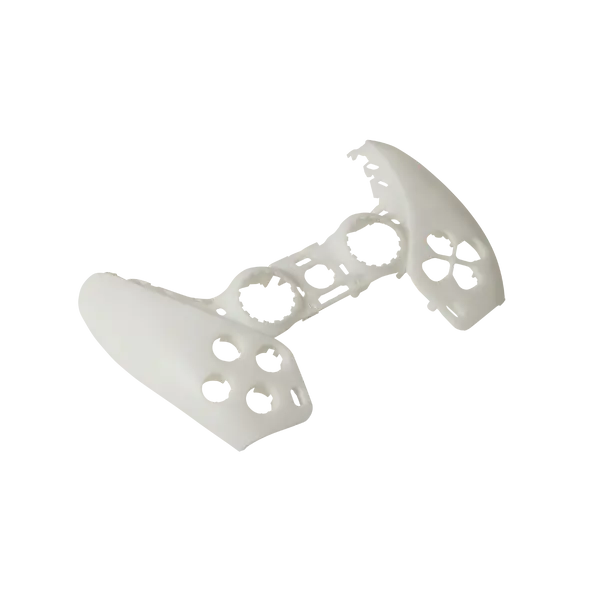
White Resin V5
SLAStiff & StrongMatteHigh StrengthHigh AccuracyFine DetailsPost-Curing Optional
SLAStiff & StrongMatteHigh StrengthHigh AccuracyFine DetailsPost-Curing Optional
White Resin is a versatile General Purpose Resin, offering an optimal balance of speed, accuracy, aesthetics, and mechanical properties to create parts that rival injection molding. Formulated specifically for the Form 4 Series, White Resin V5 prints three times faster than the previous version.

Fast Model Resin
SLAPost-Curing OptionalHigh ThroughputFast PrintingHigh Strength
SLAPost-Curing OptionalHigh ThroughputFast PrintingHigh Strength
Fast Model Resin is Formlabs’ fastest resin, capable of printing at speeds of over 100 mm per hour. Print dental models in minutes or large prototypes in less than two hours. Formulated specifically for the Form 4 ecosystem, this material prints three times faster than the previous version.
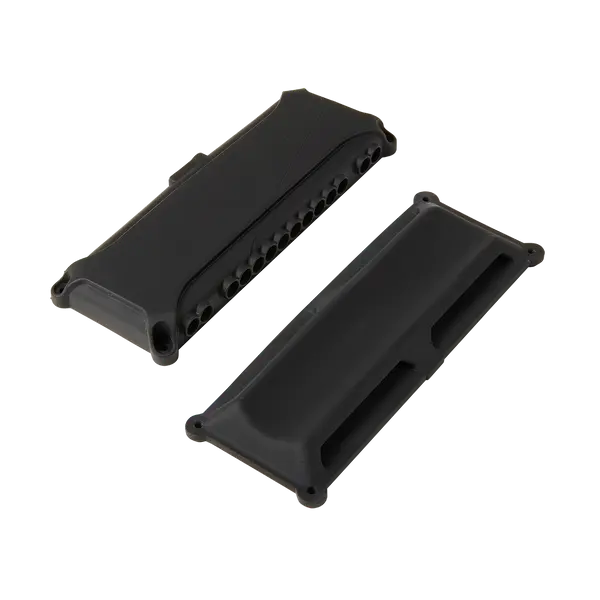
Black Resin V5
SLAStiff & StrongMatteHigh StrengthHigh AccuracyFine DetailsPost-Curing Optional
SLAStiff & StrongMatteHigh StrengthHigh AccuracyFine DetailsPost-Curing Optional
Black Resin is a versatile General Purpose Resin, offering an optimal balance of speed, accuracy, aesthetics, and mechanical properties to create parts that rival injection molding. Formulated specifically for the Form 4 ecosystem, Black Resin V5 prints 3 times faster than the previous version.
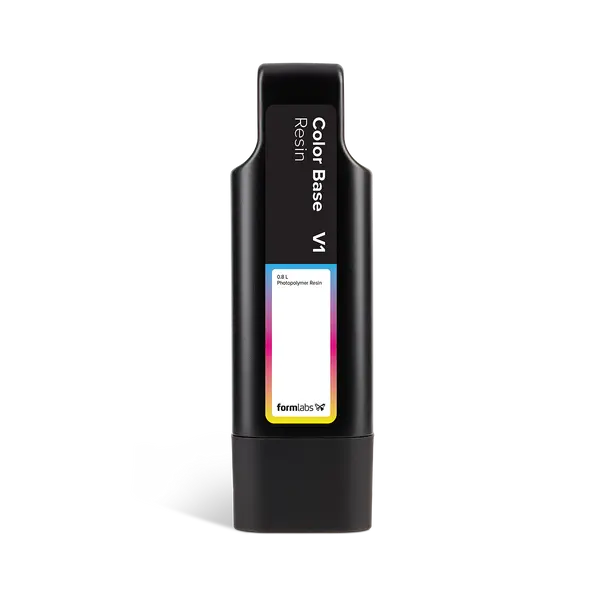
Color Kit (Form 4)
Color Kit is the first integrated color mixing solution for resin 3D printing. It enables 3D printing in a range of colors without the manual work of finishing, dying, or painting.
Color Kit contains a Color Base cartridge and all five Color Pigments. Use Color Kit to mix and print matte, opaque parts in a range of colors without the manual work of finishing and painting.
Color Kit contains a Color Base cartridge and all five Color Pigments. Use Color Kit to mix and print matte, opaque parts in a range of colors without the manual work of finishing and painting.
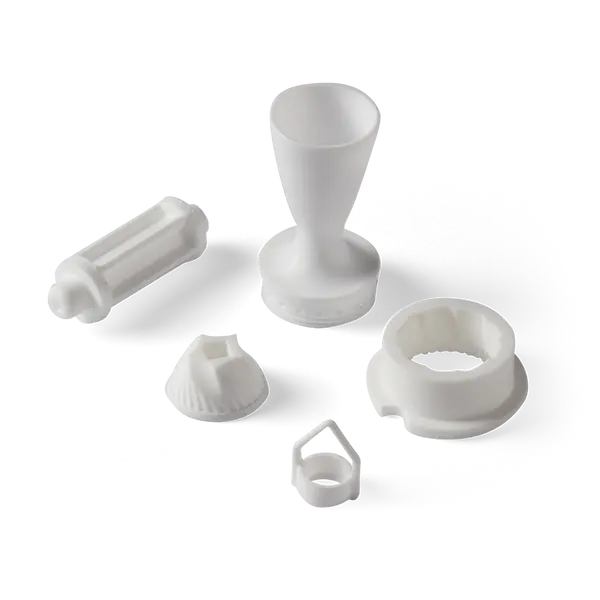
Alumina 4N Resin
SLAHeat ResistantComplex WorkflowUltra StiffUltra High StrengthCeramic
SLAHeat ResistantComplex WorkflowUltra StiffUltra High StrengthCeramic
Alumina 4N Resin is the first accessible high-density and high-purity technical ceramic 3D printing material with exceptional performance in extreme environments: thermally resistant, hard, abrasion resistant, mechanically strong, and chemically inert. Alumina 4N is a Form X material with an advanced workflow suited for expert users.

Rigid 10K Resin
SLAHeat ResistantHigh StrengthGlass FilledUltra StiffFine Details
SLAHeat ResistantHigh StrengthGlass FilledUltra StiffFine Details
Rigid 10K Resin is highly glass-filled and extremely stiff material that is similar to glass and fiber-filled thermoplastics. Use Rigid 10K Resin to rapidly produce molds, jigs, dies, and other tools, as well as functional prototypes and end use parts requiring dimensional accuracy and stability under high temperatures and pressures.
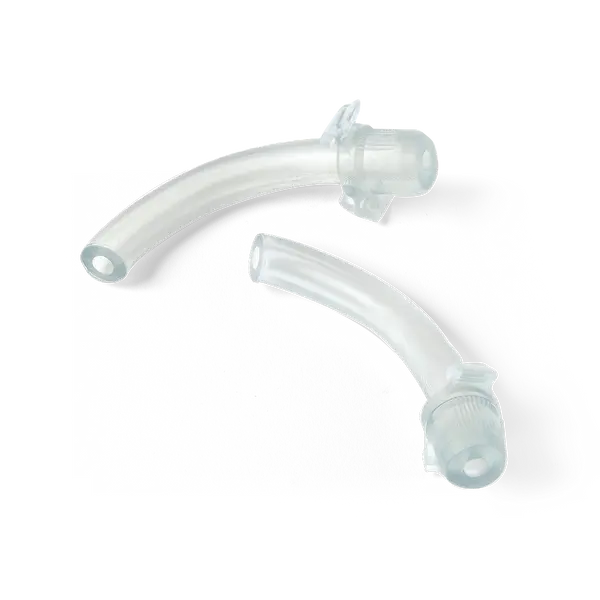
BioMed Flex 80A Resin
SLATranslucentElastomericHard Rubber-LikeBiocompatibility
SLATranslucentElastomericHard Rubber-LikeBiocompatibility
BioMed Flex 80A Resin is a firm, flexible, and transparent material for biocompatible applications requiring durability and long-term skin (>30 days) or short-term mucosal membrane contact (<24 hours). BioMed Flex 80A Resin is manufactured in our ISO 13485 certified facility.

IBT Flex Resin
SLAElastomericBiocompatibilityIndirect Bonding Trays
SLAElastomericBiocompatibilityIndirect Bonding Trays
IBT Flex Resin is a biocompatible material for indirect bonding trays and direct composite restoration guides with enhanced flexibility, strength, translucency, and color to guarantee optimal clinical outcomes, a seamless transfer of orthodontic brackets and restorative composite materials, and provide a great patient experience.

BioMed Durable Resin
SLABiocompatibilityImpact ResistantWear ResistantTransparent
SLABiocompatibilityImpact ResistantWear ResistantTransparent
BioMed Durable Resin is a transparent 3D printing material for biocompatible applications requiring impact, shatter, and abrasion resistance, as well as long-term skin (>30 days) and mucosal membrane (>30 hours) or short-term tissue, bone, and dentin contact (<24 hours).

BioMed Black Resin
SLASterilizableMatteBiocompatibility
SLASterilizableMatteBiocompatibility
BioMed Black Resin is a rigid, matte material for biocompatible applications requiring long-term skin (>30 days) or short-term mucosal membrane contact (<24 hours). Parts printed with BioMed Black Resin are compatible with common solvent disinfection and sterilization methods. BioMed Black Resin is manufactured in our ISO 13485 facility.

Castable Wax 40 Resin
SLAFine DetailsWax FilledInvestment Casting
SLAFine DetailsWax FilledInvestment Casting
Castable Wax 40 Resin is a 40% wax-filled material that offers the easiest workflow on the market for 3D printing and casting challenging, highly detailed designs, from intricate bridal jewelry to large demanding pieces. It supports a wide range of casting conditions and gypsum investments, has low expansion, and burns out cleanly.

Dental LT Clear V2 Resin
SLARobustWear ResistantBiocompatibilityHard Splints and Occlusal GuardsTransparent
SLARobustWear ResistantBiocompatibilityHard Splints and Occlusal GuardsTransparent
Dental LT Clear Resin V2 is a long-term biocompatible material for directly printing affordable, high-quality hard splints and occlusal guards in-house. Highly durable and resistant to fracture, this color-corrected material prints clear, polishes to high optical transparency, and resists discoloration over time.

Custom Tray Resin
SLACustom Impression TraysBiocompatibilityTranslucent
SLACustom Impression TraysBiocompatibilityTranslucent
Custom Tray Resin is a fast-printing biocompatible material used to directly print custom impression trays for implants, dentures, crowns and bridges, and other comprehensive cases. Digitally manufactured impression trays provide consistent, accurate impressions for high-quality dentistry.

Surgical Guide Resin
SLASterilizableTranslucentBiocompatibilitySurgical Guides
SLASterilizableTranslucentBiocompatibilitySurgical Guides
Surgical Guide Resin is an autoclavable, biocompatible resin for 3D printing dental surgical guides, drilling templates, pilot drill guides, and device sizing templates for implant placement. Surgical Guide Resin was rigorously tested to meet solvent disinfection and autoclave sterilization standards for implant systems.

Durable Resin
SLAPliableLow FrictionWear ResistantImpact ResistantPE-Like
SLAPliableLow FrictionWear ResistantImpact ResistantPE-Like
Durable Resin is a pliable, impact-resistant, and lubricious material for squeezable parts and low-friction assemblies. Parts printed in Durable Resin are robust and have low friction, with similar strength and stiffness to polyethylene (PE) and a coefficient of friction is comparable to Delrin® (POM).

High Temp Resin
SLATranslucentFine DetailsHeat ResistantUltra Stiff
SLATranslucentFine DetailsHeat ResistantUltra Stiff
High Temp Resin has a heat deflection temperature (HDT) of 238 °C @ 0.45 MPa — the highest among Formlabs resins. Choose it to print detailed, precise prototypes and end use parts with high thermal stability, such as molds and inserts, parts exposed to hot air, gas, and fluid flow, as well as heat-resistant mounts, housings, and fixtures.

Tough 1500 Resin V1
SLAPP-LikePliableWear ResistantImpact ResistantSkin Contact
SLAPP-LikePliableWear ResistantImpact ResistantSkin Contact
Tough 1500 Resin is a resilient, skin-safe material that offers similar strength and stiffness to polypropylene (PP). Choose Tough 1500 Resin for stiff and pliable parts that bend and spring back quickly, prototypes that repeatedly bend and quickly return to shape, and jigs and fixtures requiring repeated deflection.

Model V2 Resin
SLAMatteFine DetailsHigh Accuracy
SLAMatteFine DetailsHigh Accuracy
Model Resin V2 is the legacy formulation of Model Resin V3. It offers good aesthetics and accuracy, but prints more slowly than Model Resin V3. Model Resin V2 is compatible with Form 3 and Form 2 Series printers, while Precision Model Resin for the Form 4 Series offers better accuracy, faster speed, and improved aesthetics.

White Resin V4
SLAStiff & StrongMatteHigh StrengthHigh AccuracyFine Details
SLAStiff & StrongMatteHigh StrengthHigh AccuracyFine Details
White Resin is perfect for general-purpose prototyping and design, and models with intricate details. White Resin V4 is compatible with Form 3 and Form 2 Series printers. Choose White Resin V4.1 on the Form 3 Series for brighter white parts or White Resin V5 on the Form 4 Series for three times faster print speed and improved mechanical properties.

Model Resin
SLAFine DetailsMatteFast PrintingHigh Accuracy
SLAFine DetailsMatteFast PrintingHigh Accuracy
Model Resin is a fast-printing material for the production of accurate restorative models. Model Resin V3 is compatible with Form 3 and Form 2 Series printers, while Precision Model Resin for the Form 4 Series offers better accuracy, faster speed, and improved aesthetics.

Draft Resin
SLAFine DetailsHigh AccuracyHigh ThroughputFast Printing
SLAFine DetailsHigh AccuracyHigh ThroughputFast Printing
Draft Resin prints up to four times faster than Formlabs' General Purpose Resins on Form 3 and Form 2 Series printers, and is perfect for initial prototypes, rapid iterations, and orthodontic models. Fast Model Resin for the Form 4 Series offers even faster speed and improved mechanical properties.

TPU 90A Powder 6 kg
SLSElastomericImpact ResistantTear ResistantSkin ContactHard Rubber-Like
SLSElastomericImpact ResistantTear ResistantSkin ContactHard Rubber-Like
TPU 90A Powder is a tough elastomer with high elongation at break and superior tear strength for flexible, resilient, and skin-safe prototypes and end-use parts. It is ideal for flexible functional parts that withstand the demands of everyday use.

Nylon 12 GF Powder 6 kg
SLSStiff & StrongHeat ResistantLow CreepGlass FilledUV Resistant
SLSStiff & StrongHeat ResistantLow CreepGlass FilledUV Resistant
Nylon 12 GF Powder is a glass-filled, biocompatible material with enhanced stiffness and heat resistance for demanding industrial environments. Choose this material to produce stiff functional prototypes or end-use parts for applications where structural rigidity and thermal stability are critical.

Soft Tissue Starter Pack
Gingiva MasksMultiple ShadesFlexible
Gingiva MasksMultiple ShadesFlexible
Soft Tissue Starter Pack enables you to create your own Soft Tissue Resin in customizable dark, medium, and light pink shades to 3D print flexible gingiva masks for use in combination with rigid dental models to confidently check implant prosthetics by adding removable soft tissue components to your model production.

Black Pigment
SLACustom Colors
SLACustom Colors
Black Pigment creates darker shades of Color Resin when mixed with Color Base Resin. Color Kit is the first integrated color mixing solution for resin 3D printing. It enables 3D printing in a range of colors without the manual work of finishing, dying, or painting.

Magenta Pigment
SLACustom Colors
SLACustom Colors
Magenta Pigment adds pink hues to Color Resin when mixed with Color Base Resin. Color Kit is the first integrated color mixing solution for resin 3D printing. It enables 3D printing in a range of colors without the manual work of finishing, dying, or painting.

Yellow Pigment
SLACustom Colors
SLACustom Colors
Yellow Pigment adds yellow hues to Color Resin when mixed with Color Base Resin. Color Kit is the first integrated color mixing solution for resin 3D printing. It enables 3D printing in a range of colors without the manual work of finishing, dying, or painting.

Tough 2000 Resin V2
SLAStiff & StrongImpact ResistantABS-LikeWear Resistant
SLAStiff & StrongImpact ResistantABS-LikeWear Resistant
Tough 2000 Resin V2 is a rugged material with strength and stiffness comparable to acrylonitrile butadiene styrene (ABS), combining toughness with high temperature and creep resistance.

Tough 1000 Resin
SLAImpact ResistantWear ResistantHDPE-like
SLAImpact ResistantWear ResistantHDPE-like
Tough 1000 Resin is a ductile, impact-resistant material with comparable strength, stiffness, and toughness to high-density
polyethylene (HDPE), designed with exceptional wear and fatigue resistance for long-term toughness and utility.

Tough 1500 Resin V2
SLAPliablePP-LikeWear Resistant
SLAPliablePP-LikeWear Resistant
Tough 1500 Resin V2 is a resilient material with strength, stiffness, and toughness comparable to polypropylene (PP), offering exceptional resistance to fractures, impacts, and shattering.

True Cast Resin
SLAPatterns for Casting & PressingHigh AccuracyFine DetailsClean BurnoutCasting
SLAPatterns for Casting & PressingHigh AccuracyFine DetailsClean BurnoutCasting
True Cast Resin is a wax-filled 3D printing material, designed for precision casting of intricate jewelry and complex engineering components up to 5 mm.

Grey Resin V4.1
SLAStiff & StrongMatteFast PrintingHigh AccuracyFine Details
SLAStiff & StrongMatteFast PrintingHigh AccuracyFine Details
Grey Resin is ideal for general-purpose prototyping and detailed models, offering a matte finish, opaque appearance, and precise details. Grey Resin V4 is compatible with Form 3 and Form 2 Series printers, while Grey Resin V5 for the Form 4 Series offers faster speed and improved mechanical properties.

Black Resin V4.1
SLAStiff & StrongMatteHigh StrengthHigh AccuracyFine Details
SLAStiff & StrongMatteHigh StrengthHigh AccuracyFine Details
Black Resin is perfect for general-purpose prototyping and design, and models with intricate details. Black Resin V4.1 is compatible with Form 3 Series printers, produces deeper black parts, and offers improved print reliability compared to Black Resin V4.0. Choose Black Resin V5 on the Form 4 Series for three times faster print speed and improved mechanical properties.

White Resin V4.1
SLAStiff & StrongFine DetailsHigh StrengthHigh Accuracy
SLAStiff & StrongFine DetailsHigh StrengthHigh Accuracy
White Resin is perfect for general-purpose prototyping and design, and models with intricate details. White Resin V4.1 is compatible with Form 3 Series printers and produces brighter white parts compared to White Resin V4. Choose White Resin V5 on the Form 4 Series for three times faster print speed and improved mechanical properties.

Clear Resin V4.1
SLAStiff & StrongHigh StrengthTransparentHigh AccuracyFine Details
SLAStiff & StrongHigh StrengthTransparentHigh AccuracyFine Details
Clear Resin is a rigid material that polishes to near optical transparency. Clear Resin V4.1 is compatible with Form 3 Series printers and creates more color-neutral and transparent parts compared to Clear Resin V4.0. Choose Clear Resin V5 on the Form 4 Series for three times faster print speed and improved mechanical properties.

Nylon 12 Tough Powder 10 kg
SLSRobustHigh StrengthWear ResistantUV ResistantBiocompatibility
SLSRobustHigh StrengthWear ResistantUV ResistantBiocompatibility
Nylon 12 Tough Powder offers the best-in-class refresh rate among Nylon powders, high ductility, and great dimensional accuracy across the build chamber. Print more durable parts for prototyping and small batch production that have reduced warpage without sacrificing strength.

Premium Teeth Resin
SLAMultiple ShadesWear ResistantDenture TeethBiocompatibilityTemporary Full-Arch Implant-Supported Restorations (All-on-X)
SLAMultiple ShadesWear ResistantDenture TeethBiocompatibilityTemporary Full-Arch Implant-Supported Restorations (All-on-X)
Premium Teeth Resin is a nano-ceramic-filled biocompatible material with enhanced aesthetics, mechanical properties, and validated longevity to guarantee optimal clinical performance. 3D print denture teeth, temporary full-arch implant-supported restorations (All-on-X appliances), temporary single units (crowns, inlays, onlays, and veneers), and up to seven-unit bridges.

Denture Base Resin
SLAMultiple ShadesDenture BasesWear ResistantBiocompatibility
SLAMultiple ShadesDenture BasesWear ResistantBiocompatibility
Denture Base Resin is a biocompatible material for producing long-lasting, wear-resistant denture bases and try-in dentures at a fraction of the cost of traditional methods. With four semi-translucent shades available, technicians can achieve lifelike gingiva with natural margins, whether with 3D printed denture teeth or acrylic cards.

BEGO™ VarseoSmile® TriniQ® Resin
SLAMultiple ShadesCeramic FilledWear ResistantBiocompatibilityPermanent Restorations
SLAMultiple ShadesCeramic FilledWear ResistantBiocompatibilityPermanent Restorations
BEGO™ VarseoSmile® TriniQ® Resin is a versatile ceramic-filled biocompatible material, indicated for temporary and permanent single units (crowns, inlays, onlays, and veneers) and bridges, and denture teeth.

Clear Cast Resin
SLAFine DetailsInvestment CastingTransparentHigh Accuracy
SLAFine DetailsInvestment CastingTransparentHigh Accuracy
Clear Cast Resin is a resin designed for investment casting, to directly print patterns that can be invested and cast. It has an extremely low thermal expansion, low ash, and no trace heavy metals.

Nylon 12 White Powder 10 kg
SLSRobustHigh StrengthWear ResistantUV ResistantBiocompatibility
SLSRobustHigh StrengthWear ResistantUV ResistantBiocompatibility
Nylon 12 White Powder combines all of the great qualities of the general purpose and biocompatible Nylon 12 Powder with the customizability of white parts. Create functional prototypes and end-use customer-facing parts that can be easily dyed to match brand aesthetics as well as medical devices and models with high contrast and detail.

Nylon 12 Powder 10 kg
SLSRobustHigh StrengthWear ResistantUV ResistantBiocompatibility
SLSRobustHigh StrengthWear ResistantUV ResistantBiocompatibility
Nylon 12 Powder is a general purpose, versatile, and biocompatible material with high detail and great dimensional accuracy. As the go-to material for SLS 3D printing, it is ideal for both functional prototyping and end-use production of complex assemblies and durable parts with high environmental stability.

White Resin V5
SLAStiff & StrongMatteHigh StrengthHigh AccuracyFine DetailsPost-Curing Optional
SLAStiff & StrongMatteHigh StrengthHigh AccuracyFine DetailsPost-Curing Optional
White Resin is a versatile General Purpose Resin, offering an optimal balance of speed, accuracy, aesthetics, and mechanical properties to create parts that rival injection molding. Formulated specifically for the Form 4 Series, White Resin V5 prints three times faster than the previous version.

Grey Resin V5
SLAStiff & StrongMatteFast PrintingHigh AccuracyFine DetailsPost-Curing Optional
SLAStiff & StrongMatteFast PrintingHigh AccuracyFine DetailsPost-Curing Optional
Grey Resin is a versatile General Purpose Resin, offering an optimal balance of speed, accuracy, aesthetics, and mechanical properties to create parts that rival injection molding. Formulated specifically for the Form 4 Series, Grey Resin V5 prints three times faster than the previous version.

Fast Model Resin
SLAPost-Curing OptionalHigh ThroughputFast PrintingHigh Strength
SLAPost-Curing OptionalHigh ThroughputFast PrintingHigh Strength
Fast Model Resin is Formlabs’ fastest resin, capable of printing at speeds of over 100 mm per hour. Print dental models in minutes or large prototypes in less than two hours. Formulated specifically for the Form 4 ecosystem, this material prints three times faster than the previous version.

Clear Resin V5
SLAStiff & StrongHigh StrengthTransparentHigh AccuracyFine DetailsPost-Curing Optional
SLAStiff & StrongHigh StrengthTransparentHigh AccuracyFine DetailsPost-Curing Optional
Clear Resin is an exceptionally clear 3D printing resin formulated to leverage the new Form 4 ecosystem, offering an optimal balance of fast print speed, high accuracy, transparency, and strong mechanical properties to create parts that can be coated or polished to rival acrylic.

Black Resin V5
SLAStiff & StrongMatteHigh StrengthHigh AccuracyFine DetailsPost-Curing Optional
SLAStiff & StrongMatteHigh StrengthHigh AccuracyFine DetailsPost-Curing Optional
Black Resin is a versatile General Purpose Resin, offering an optimal balance of speed, accuracy, aesthetics, and mechanical properties to create parts that rival injection molding. Formulated specifically for the Form 4 ecosystem, Black Resin V5 prints 3 times faster than the previous version.

Precision Model Resin
SLAMatteHigh AccuracyFine Details
SLAMatteHigh AccuracyFine Details
Precision Model Resin is a high-accuracy material for creating restorative models with high opacity, beige color, and a smooth, matte finish to capture fine details and create crisp margin lines. Formulated specifically for the Form 4 ecosystem, this material prints three times faster than the previous version.

Color Kit (Form 4)
Color Kit is the first integrated color mixing solution for resin 3D printing. It enables 3D printing in a range of colors without the manual work of finishing, dying, or painting.
Color Kit contains a Color Base cartridge and all five Color Pigments. Use Color Kit to mix and print matte, opaque parts in a range of colors without the manual work of finishing and painting.
Color Kit contains a Color Base cartridge and all five Color Pigments. Use Color Kit to mix and print matte, opaque parts in a range of colors without the manual work of finishing and painting.

Flame Retardant Resin
SLAStiff & StrongHeat ResistantRobustLow CreepUL94 V0 Certified
SLAStiff & StrongHeat ResistantRobustLow CreepUL94 V0 Certified
Flame Retardant Resin is a UL 94 V-0 certified, halogen-free material with favorable flame, smoke, and toxicity (FST) ratings for creating self-extinguishing parts. Parts printed in FR Resin are stiff and creep-resistant, and will perform well long-term in indoor and industrial environments with high temperatures or ignition sources.

Alumina 4N Resin
SLAHeat ResistantComplex WorkflowUltra StiffUltra High StrengthCeramic
SLAHeat ResistantComplex WorkflowUltra StiffUltra High StrengthCeramic
Alumina 4N Resin is the first accessible high-density and high-purity technical ceramic 3D printing material with exceptional performance in extreme environments: thermally resistant, hard, abrasion resistant, mechanically strong, and chemically inert. Alumina 4N is a Form X material with an advanced workflow suited for expert users.

Color Base Resin
SLAFine DetailsCustom ColorsMatte
SLAFine DetailsCustom ColorsMatte
Color Kit is the first integrated color mixing solution for resin 3D printing. It enables 3D printing in a range of colors without the manual work of finishing, dying, or painting. Color Base Resin is the foundation to mix with any Color Kit pigment and create Color Resin.

Rigid 10K Resin
SLAHeat ResistantHigh StrengthGlass FilledUltra StiffFine Details
SLAHeat ResistantHigh StrengthGlass FilledUltra StiffFine Details
Rigid 10K Resin is highly glass-filled and extremely stiff material that is similar to glass and fiber-filled thermoplastics. Use Rigid 10K Resin to rapidly produce molds, jigs, dies, and other tools, as well as functional prototypes and end use parts requiring dimensional accuracy and stability under high temperatures and pressures.

Elastic 50A Resin V2
SLATranslucentElastomericSoft Silicone-like
SLATranslucentElastomericSoft Silicone-like
Elastic 50A Resin V2 is a soft, translucent elastomer with a 50A Shore durometer that is ideal for prototyping parts normally produced with softer rubbers and silicones. Parts printed in Elastic 50A Resin will bend, stretch, compress, and hold up to repeated cycles without tearing, and spring back quickly to their original shape.

BioMed Flex 80A Resin
SLATranslucentElastomericHard Rubber-LikeBiocompatibility
SLATranslucentElastomericHard Rubber-LikeBiocompatibility
BioMed Flex 80A Resin is a firm, flexible, and transparent material for biocompatible applications requiring durability and long-term skin (>30 days) or short-term mucosal membrane contact (<24 hours). BioMed Flex 80A Resin is manufactured in our ISO 13485 certified facility.

BioMed Elastic 50A Resin
SLAElastomericSoft Silicone-likeBiocompatibilityTranslucent
SLAElastomericSoft Silicone-likeBiocompatibilityTranslucent
BioMed Elastic 50A Resin is a soft, elastic, and transparent material for biocompatible applications requiring comfort and long-term skin (>30 days) or short-term mucosal membrane contact (<24 hours). BioMed Elastic 50A Resin is manufactured in our ISO 13485 certified facility.

IBT Flex Resin
SLAElastomericBiocompatibilityIndirect Bonding Trays
SLAElastomericBiocompatibilityIndirect Bonding Trays
IBT Flex Resin is a biocompatible material for indirect bonding trays and direct composite restoration guides with enhanced flexibility, strength, translucency, and color to guarantee optimal clinical outcomes, a seamless transfer of orthodontic brackets and restorative composite materials, and provide a great patient experience.

Dental LT Comfort Resin
SLAFlexibleWear ResistantBiocompatibilityFlexible Splints and Occlusal GuardsTransparent
SLAFlexibleWear ResistantBiocompatibilityFlexible Splints and Occlusal GuardsTransparent
Dental LT Comfort Resin is a long-term biocompatible material for directly 3D printing flexible occlusal splints and night guards in-house, more easily than ever. Printed appliances are easily polished to high optical transparency, and offer enhanced comfort and durability that boosts patient adoption and compliance.

BioMed Durable Resin
SLABiocompatibilityImpact ResistantWear ResistantTransparent
SLABiocompatibilityImpact ResistantWear ResistantTransparent
BioMed Durable Resin is a transparent 3D printing material for biocompatible applications requiring impact, shatter, and abrasion resistance, as well as long-term skin (>30 days) and mucosal membrane (>30 hours) or short-term tissue, bone, and dentin contact (<24 hours).
Silicone 40A Resin
SLAElastomericSoft100% SiliconeWear ResistantTear Resistant
SLAElastomericSoft100% SiliconeWear ResistantTear Resistant
Silicone 40A Resin is the first accessible 100% silicone 3D printing material, using Formlabs’ patent-pending Pure Silicone Technology™. Eliminate molding and labor-intensive casting processes by directly printing soft, pliable, and durable silicone parts in house in a matter of hours.

BioMed Black Resin
SLASterilizableMatteBiocompatibility
SLASterilizableMatteBiocompatibility
BioMed Black Resin is a rigid, matte material for biocompatible applications requiring long-term skin (>30 days) or short-term mucosal membrane contact (<24 hours). Parts printed with BioMed Black Resin are compatible with common solvent disinfection and sterilization methods. BioMed Black Resin is manufactured in our ISO 13485 facility.

BioMed White Resin
SLASterilizableMatteBiocompatibility
SLASterilizableMatteBiocompatibility
BioMed White Resin is a rigid material for biocompatible applications requiring long-term skin (>30 days) or short-term bone, tissue, dentin, and mucosal membrane contact (<24 hours). BioMed White Resin is manufactured in our ISO 13485 facility.

Castable Wax 40 Resin
SLAFine DetailsWax FilledInvestment Casting
SLAFine DetailsWax FilledInvestment Casting
Castable Wax 40 Resin is a 40% wax-filled material that offers the easiest workflow on the market for 3D printing and casting challenging, highly detailed designs, from intricate bridal jewelry to large demanding pieces. It supports a wide range of casting conditions and gypsum investments, has low expansion, and burns out cleanly.

BioMed Amber Resin
SLAStiff & StrongTranslucentSterilizableBiocompatibilityUltra High Strength
SLAStiff & StrongTranslucentSterilizableBiocompatibilityUltra High Strength
BioMed Amber Resin is a strong, stiff material for biocompatible applications requiring long-term skin (>30 days) or short-term bone, tissue, dentin, and mucosal membrane contact (<24 hours). Parts printed with BioMed Amber Resin are compatible with common solvent disinfection and sterilization methods.

Dental LT Clear V2 Resin
SLARobustWear ResistantBiocompatibilityHard Splints and Occlusal GuardsTransparent
SLARobustWear ResistantBiocompatibilityHard Splints and Occlusal GuardsTransparent
Dental LT Clear Resin V2 is a long-term biocompatible material for directly printing affordable, high-quality hard splints and occlusal guards in-house. Highly durable and resistant to fracture, this color-corrected material prints clear, polishes to high optical transparency, and resists discoloration over time.

ESD Resin
SLAStiff & StrongABS-LikeESD-SafeRobust
SLAStiff & StrongABS-LikeESD-SafeRobust
ESD Resin is a specialty material for producing custom ESD-safe prototypes and production tooling to increase operational efficiency and improve the yield of electronics manufacturing lines. Parts printed in ESD Resin are static-dissipative, repel dust and powder, and have high modulus and impact strength similar to ABS.

Custom Tray Resin
SLACustom Impression TraysBiocompatibilityTranslucent
SLACustom Impression TraysBiocompatibilityTranslucent
Custom Tray Resin is a fast-printing biocompatible material used to directly print custom impression trays for implants, dentures, crowns and bridges, and other comprehensive cases. Digitally manufactured impression trays provide consistent, accurate impressions for high-quality dentistry.

Castable Wax Resin
SLAFine DetailsWax FilledInvestment Casting
SLAFine DetailsWax FilledInvestment Casting
Castable Wax Resin is a 20% wax-filled material for casting that can capture intricate features and offers a smooth surface finish for accurate castings with zero ash content and clean burnout. It is ideal for ultrafine structures in jewelry, as well as highly accurate patterns for casting and pressing dental prosthetics.

Surgical Guide Resin
SLASterilizableTranslucentBiocompatibilitySurgical Guides
SLASterilizableTranslucentBiocompatibilitySurgical Guides
Surgical Guide Resin is an autoclavable, biocompatible resin for 3D printing dental surgical guides, drilling templates, pilot drill guides, and device sizing templates for implant placement. Surgical Guide Resin was rigorously tested to meet solvent disinfection and autoclave sterilization standards for implant systems.

BioMed Clear Resin
SLASterilizableRobustHigh StrengthBiocompatibilityTransparent
SLASterilizableRobustHigh StrengthBiocompatibilityTransparent
BioMed Clear Resin is a hard, strong, and wear-resistant material for biocompatible applications requiring long-term skin (>30 days), breathing gas pathways, and mucosal membrane contact (>30 hours) or short-term bone, tissue, and dentin (<24 hours). Parts printed with BioMed Clear Resin are compatible with common sterilization methods.

Durable Resin
SLAPliableLow FrictionWear ResistantImpact ResistantPE-Like
SLAPliableLow FrictionWear ResistantImpact ResistantPE-Like
Durable Resin is a pliable, impact-resistant, and lubricious material for squeezable parts and low-friction assemblies. Parts printed in Durable Resin are robust and have low friction, with similar strength and stiffness to polyethylene (PE) and a coefficient of friction is comparable to Delrin® (POM).

Flexible 80A Resin
SLATranslucentHard Rubber-LikeElastomericWear Resistant
SLATranslucentHard Rubber-LikeElastomericWear Resistant
Flexible 80A Resin a stiff, soft-touch, translucent elastomer with an 80A Shore durometer that is ideal for prototyping rubber-like parts with the flexibility of harder rubber or TPU. Parts printed in Flexible 80A Resin can withstand bending, flexing, and compression, even through repeated cycles.

High Temp Resin
SLATranslucentFine DetailsHeat ResistantUltra Stiff
SLATranslucentFine DetailsHeat ResistantUltra Stiff
High Temp Resin has a heat deflection temperature (HDT) of 238 °C @ 0.45 MPa — the highest among Formlabs resins. Choose it to print detailed, precise prototypes and end use parts with high thermal stability, such as molds and inserts, parts exposed to hot air, gas, and fluid flow, as well as heat-resistant mounts, housings, and fixtures.

Rigid 4000 Resin
SLAHigh StrengthGlass FilledUltra StiffPEEK-LikeFine Details
SLAHigh StrengthGlass FilledUltra StiffPEEK-LikeFine Details
Rigid 4000 Resin is a glass-filled resin that is stiff, precise, and offers high thermal and chemical resistance. It prints with a smooth, polished finish and is ideal for industrial parts that need to withstand significant load without bending. Parts printed in Rigid 4000 have similar stiffness to PEEK and PEKK thermoplastics.

Tough 1500 Resin V1
SLAPP-LikePliableWear ResistantImpact ResistantSkin Contact
SLAPP-LikePliableWear ResistantImpact ResistantSkin Contact
Tough 1500 Resin is a resilient, skin-safe material that offers similar strength and stiffness to polypropylene (PP). Choose Tough 1500 Resin for stiff and pliable parts that bend and spring back quickly, prototypes that repeatedly bend and quickly return to shape, and jigs and fixtures requiring repeated deflection.

Grey Pro Resin
SLAFine DetailsMatteLow CreepHigh Strength
SLAFine DetailsMatteLow CreepHigh Strength
Grey Pro Resin is a tough and heat-resistant material with a low creep, offering improved performance compared to Formlabs General Purpose Resins. Grey Pro Resin is compatible with Form 2 and Form 3 Series printers, while Grey Resin V5 for the Form 4 Series offers improved mechanical properties and faster speed, replacing Grey Pro Resin.

Model V2 Resin
SLAMatteFine DetailsHigh Accuracy
SLAMatteFine DetailsHigh Accuracy
Model Resin V2 is the legacy formulation of Model Resin V3. It offers good aesthetics and accuracy, but prints more slowly than Model Resin V3. Model Resin V2 is compatible with Form 3 and Form 2 Series printers, while Precision Model Resin for the Form 4 Series offers better accuracy, faster speed, and improved aesthetics.

Black Resin V4
SLAStiff & StrongMatteHigh StrengthHigh AccuracyFine Details
SLAStiff & StrongMatteHigh StrengthHigh AccuracyFine Details
Black Resin is perfect for general-purpose prototyping and design, and models with intricate details. Black Resin V4 is compatible with Form 3 and Form 2 Series printers. Choose Black Resin V4.1 on the Form 3 Series for deeper black parts and improved print reliability or Black Resin V5 on the Form 4 Series for three times faster print speed and improved mechanical properties.

White Resin V4
SLAStiff & StrongMatteHigh StrengthHigh AccuracyFine Details
SLAStiff & StrongMatteHigh StrengthHigh AccuracyFine Details
White Resin is perfect for general-purpose prototyping and design, and models with intricate details. White Resin V4 is compatible with Form 3 and Form 2 Series printers. Choose White Resin V4.1 on the Form 3 Series for brighter white parts or White Resin V5 on the Form 4 Series for three times faster print speed and improved mechanical properties.

Tough 2000 Resin
SLAStiff & StrongABS-LikeHigh StrengthWear ResistantImpact Resistant
SLAStiff & StrongABS-LikeHigh StrengthWear ResistantImpact Resistant
Tough 2000 Resin has similar strength and stiffness to ABS plastics, making it ideal for functional parts that are difficult to bend and will hold up with extended use. Choose Tough 2000 Resin for prototyping strong and sturdy parts that should not bend easily, as well as jigs and fixtures requiring minimal deflection.

Model Resin
SLAFine DetailsMatteFast PrintingHigh Accuracy
SLAFine DetailsMatteFast PrintingHigh Accuracy
Model Resin is a fast-printing material for the production of accurate restorative models. Model Resin V3 is compatible with Form 3 and Form 2 Series printers, while Precision Model Resin for the Form 4 Series offers better accuracy, faster speed, and improved aesthetics.

Clear Resin V4
SLAStiff & StrongHigh StrengthTransparentHigh AccuracyFine Details
SLAStiff & StrongHigh StrengthTransparentHigh AccuracyFine Details
Clear Resin is a rigid material that polishes to near optical transparency. Clear Resin V4 is compatible with Form 3 and Form 2 Series printers. Choose Clear Resin V4.1 on the Form 3 Series for more color-neutral and transparent parts or Clear Resin V5 on the Form 4 Series for three times faster print speed and improved mechanical properties.

Draft Resin
SLAFine DetailsHigh AccuracyHigh ThroughputFast Printing
SLAFine DetailsHigh AccuracyHigh ThroughputFast Printing
Draft Resin prints up to four times faster than Formlabs' General Purpose Resins on Form 3 and Form 2 Series printers, and is perfect for initial prototypes, rapid iterations, and orthodontic models. Fast Model Resin for the Form 4 Series offers even faster speed and improved mechanical properties.

Grey Resin V4
SLAStiff & StrongMatteFast PrintingHigh AccuracyFine Details
SLAStiff & StrongMatteFast PrintingHigh AccuracyFine Details
Grey Resin is ideal for general-purpose prototyping and detailed models, offering a matte finish, opaque appearance, and precise details. Grey Resin V4 is compatible with Form 3 and Form 2 Series printers, while Grey Resin V5 for the Form 4 Series offers faster speed and improved mechanical properties.

TPU 90A Powder 6 kg
SLSElastomericImpact ResistantTear ResistantSkin ContactHard Rubber-Like
SLSElastomericImpact ResistantTear ResistantSkin ContactHard Rubber-Like
TPU 90A Powder is a tough elastomer with high elongation at break and superior tear strength for flexible, resilient, and skin-safe prototypes and end-use parts. It is ideal for flexible functional parts that withstand the demands of everyday use.

Nylon 11 CF Powder 6 kg
SLSHeat ResistantCarbon Fiber FilledUltra StiffImpact ResistantUltra High Strength
SLSHeat ResistantCarbon Fiber FilledUltra StiffImpact ResistantUltra High Strength
Nylon 11 CF Powder is a carbon fiber-filled material, perfect for applications that require both superior stiffness and strength. Produce lightweight, rigid parts that remain structurally and thermally stable and can sustain repeated impact. Nylon 11 CF Powder requires to be printed on Fuse 1+ 30W with inert atmospheric control.

Nylon 12 GF Powder 6 kg
SLSStiff & StrongHeat ResistantLow CreepGlass FilledUV Resistant
SLSStiff & StrongHeat ResistantLow CreepGlass FilledUV Resistant
Nylon 12 GF Powder is a glass-filled, biocompatible material with enhanced stiffness and heat resistance for demanding industrial environments. Choose this material to produce stiff functional prototypes or end-use parts for applications where structural rigidity and thermal stability are critical.

Nylon 11 Powder 6 kg
SLSHigh StrengthWear ResistantImpact ResistantUV ResistantSkin Contact
SLSHigh StrengthWear ResistantImpact ResistantUV ResistantSkin Contact
Nylon 11 Powder is a strong and highly ductile bio-based material. It is ideal for robust biocompatible parts, functional prototyping, and producing custom or low volume end-use parts that need to bend or take impact. For best results, print Nylon 11 Powder using the Fuse 1+ 30W and optional inert atmospheric control.

Soft Tissue Starter Pack
Gingiva MasksMultiple ShadesFlexible
Gingiva MasksMultiple ShadesFlexible
Soft Tissue Starter Pack enables you to create your own Soft Tissue Resin in customizable dark, medium, and light pink shades to 3D print flexible gingiva masks for use in combination with rigid dental models to confidently check implant prosthetics by adding removable soft tissue components to your model production.

Color Kit (Form 3)
SLAFine DetailsMatteCustom Colors
SLAFine DetailsMatteCustom Colors
Color Kit is the first integrated color mixing solution for resin 3D printing. It enables 3D printing in a range of colors without the manual work of finishing, dying, or painting. Color Kit contains a Color Base cartridge and all five Color Pigments to mix and print matte, opaque parts in a range of colors.

Black Pigment
SLACustom Colors
SLACustom Colors
Black Pigment creates darker shades of Color Resin when mixed with Color Base Resin. Color Kit is the first integrated color mixing solution for resin 3D printing. It enables 3D printing in a range of colors without the manual work of finishing, dying, or painting.

Cyan Pigment
SLACustom Colors
SLACustom Colors
Cyan Pigment adds blue hues to Color Resin when mixed with Color Base Resin. Color Kit is the first integrated color mixing solution for resin 3D printing. It enables 3D printing in a range of colors without the manual work of finishing, dying, or painting.

Magenta Pigment
SLACustom Colors
SLACustom Colors
Magenta Pigment adds pink hues to Color Resin when mixed with Color Base Resin. Color Kit is the first integrated color mixing solution for resin 3D printing. It enables 3D printing in a range of colors without the manual work of finishing, dying, or painting.

White Pigment
SLACustom Colors
SLACustom Colors
White Pigment creates lighter shades of Color Resin when mixed with Color Base Resin. Color Kit is the first integrated color mixing solution for resin 3D printing. It enables 3D printing in a range of colors without the manual work of finishing, dying, or painting.

Yellow Pigment
SLACustom Colors
SLACustom Colors
Yellow Pigment adds yellow hues to Color Resin when mixed with Color Base Resin. Color Kit is the first integrated color mixing solution for resin 3D printing. It enables 3D printing in a range of colors without the manual work of finishing, dying, or painting.
What Material is Right for You?
Compare All MaterialsSLA
Alumina 4N Resin
BioMed Amber Resin
BioMed Black Resin
BioMed Clear Resin
BioMed Durable Resin
BioMed Elastic 50A Resin
BioMed Flex 80A Resin
BioMed White Resin
Black Resin V4
Black Resin V4.1
Black Resin V5
Clear Resin V4
Clear Resin V4.1
Clear Resin V5
Color Kit
Custom Tray Resin
Dental LT Clear V2 Resin
Dental LT Comfort Resin
Denture Base Resin
Draft Resin
Durable Resin
ESD Resin
Elastic 50A Resin V2
Fast Model Resin
Flame Retardant Resin
Flexible 80A Resin
Grey Pro Resin
Grey Resin V4
Grey Resin V5
High Temp Resin
IBT Flex Resin
Model Resin
Model V2 Resin
Precision Model Resin
Premium Teeth Resin
Rigid 10K Resin
Rigid 4000 Resin
Silicone 40A Resin
Surgical Guide Resin
Tough 1000 Resin
Tough 1500 Resin
Tough 1500 Resin V2
Tough 2000 Resin
Tough 2000 Resin V2
White Resin V4
White Resin V4.1
White Resin V5
SLS
Nylon 11 CF Powder
Nylon 11 Powder
Nylon 12 GF Powder
Nylon 12 Powder
Nylon 12 Tough Powder
Nylon 12 White Powder
TPU 90A Powder
SLA
Alumina 4N Resin
BioMed Amber Resin
BioMed Black Resin
BioMed Clear Resin
BioMed Durable Resin
BioMed Elastic 50A Resin
BioMed Flex 80A Resin
BioMed White Resin
Black Resin V4
Black Resin V4.1
Black Resin V5
Clear Resin V4
Clear Resin V4.1
Clear Resin V5
Color Kit
Custom Tray Resin
Dental LT Clear V2 Resin
Dental LT Comfort Resin
Denture Base Resin
Draft Resin
Durable Resin
ESD Resin
Elastic 50A Resin V2
Fast Model Resin
Flame Retardant Resin
Flexible 80A Resin
Grey Pro Resin
Grey Resin V4
Grey Resin V5
High Temp Resin
IBT Flex Resin
Model Resin
Model V2 Resin
Precision Model Resin
Premium Teeth Resin
Rigid 10K Resin
Rigid 4000 Resin
Silicone 40A Resin
Surgical Guide Resin
Tough 1000 Resin
Tough 1500 Resin
Tough 1500 Resin V2
Tough 2000 Resin
Tough 2000 Resin V2
White Resin V4
White Resin V4.1
White Resin V5
SLS
Nylon 11 CF Powder
Nylon 11 Powder
Nylon 12 GF Powder
Nylon 12 Powder
Nylon 12 Tough Powder
Nylon 12 White Powder
TPU 90A Powder
Overview
Tough 1500 Resin V2 is a resilient material with strength, stiffness, and toughness comparable to polypropylene (PP), offering exceptional resistance to fractures, impacts, and shattering.
Fast Model Resin is Formlabs’ fastest resin, capable of printing at speeds of over 100 mm per hour. Print dental models in minutes or large prototypes in less than two hours. Formulated specifically for the Form 4 ecosystem, this material prints three times faster than the previous version.
Material properties1
34 MPa
Ultimate Tensile Strength
62 MPa
Ultimate Tensile Strength
41 MPa
Flexural Strength
106 MPa
Flexural Strength
1,370 MPa
Flexural Modulus
2,740 MPa
Flexural Modulus
42 J/m
Notched Izod
37 J/m
Notched Izod
155 %
Elongation at Break
11 %
Elongation at Break
53 °C
Heat Deflection Temp. @ 1.8 MPa
61 °C
Heat Deflection Temp. @ 1.8 MPa
66 °C
Heat Deflection Temp. @ 0.45 MPa
76 °C
Heat Deflection Temp. @ 0.45 MPa
1,460 MPa
Tensile Modulus
2,670 MPa
Tensile Modulus
910 J/m
Unnotched Izod
—
Unnotched Izod
1,090 J/m
Work of Fracture (Wf)
—
Work of Fracture (Wf)
1.7 MPa-m1/2
Maximum Stress Intensity Factor (Kmax)
—
Maximum Stress Intensity Factor (Kmax)
5.9 J
Gardner at 1/32" (0.97 mm) thickness
—
Gardner at 1/32" (0.97 mm) thickness
11.1 J
Gardner at 1/16" (1.9 mm) thickness
—
Gardner at 1/16" (1.9 mm) thickness
8,000 cycles
Ross Flexing Fatigue
—
Ross Flexing Fatigue
Tough 1500 Resin V2
Fast Model Resin
Ultimate Tensile Strength (MPa)
34
62
0
16
31
47
62
Flexural Strength (MPa)
41
106
0
27
53
80
106
Flexural Modulus (MPa)
1370
2740
0
685
1370
2055
2740
Notched Izod (J/m)
42
37
0
11
21
32
42
Unnotched Izod (J/m)
910
No Measurement
0
228
455
683
910
Elongation at Break (%)
155
11
0
39
78
117
155
Heat Deflection Temp. @ 1.8 MPa (°C)
53
61
0
16
31
46
61
Heat Deflection Temp. @ 0.45 MPa (°C)
66
76
0
19
38
57
76
Work of Fracture (Wf) (J/m)
1090
No Measurement
0
273
545
818
1090
Maximum Stress Intensity Factor (Kmax) (MPa-m1/2)
1.7
No Measurement
0.00
0.42
0.85
1.27
1.70
Tensile Modulus (MPa)
1460
2670
0
668
1335
2003
2670
Gardner at 1/32" (0.97 mm) thickness (J)
5.9
No Measurement
0.0
1.5
3.0
4.4
5.9
Gardner at 1/16" (1.9 mm) thickness (J)
11.1
No Measurement
0
3
6
9
12
Ross Flexing Fatigue (cycles)
8000
No Measurement
0
2000
4000
6000
8000
1: Post-cured measurements. See more details in material properties data
